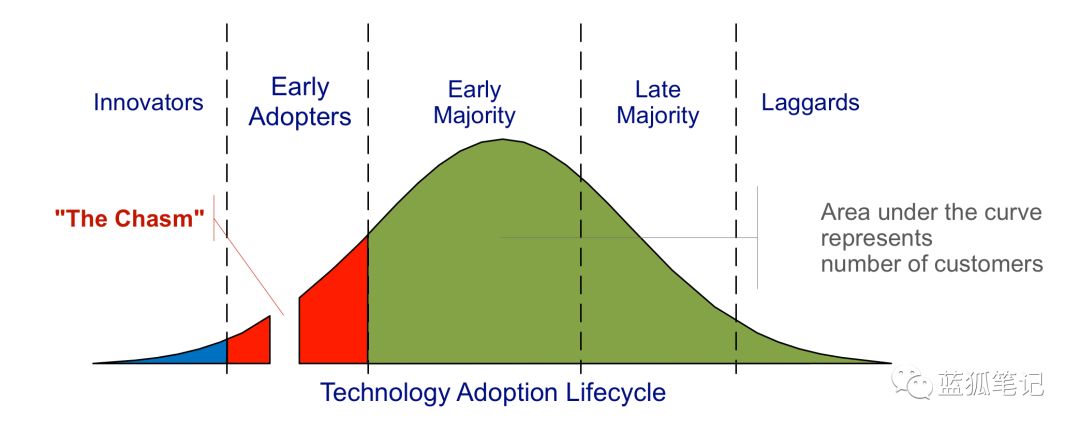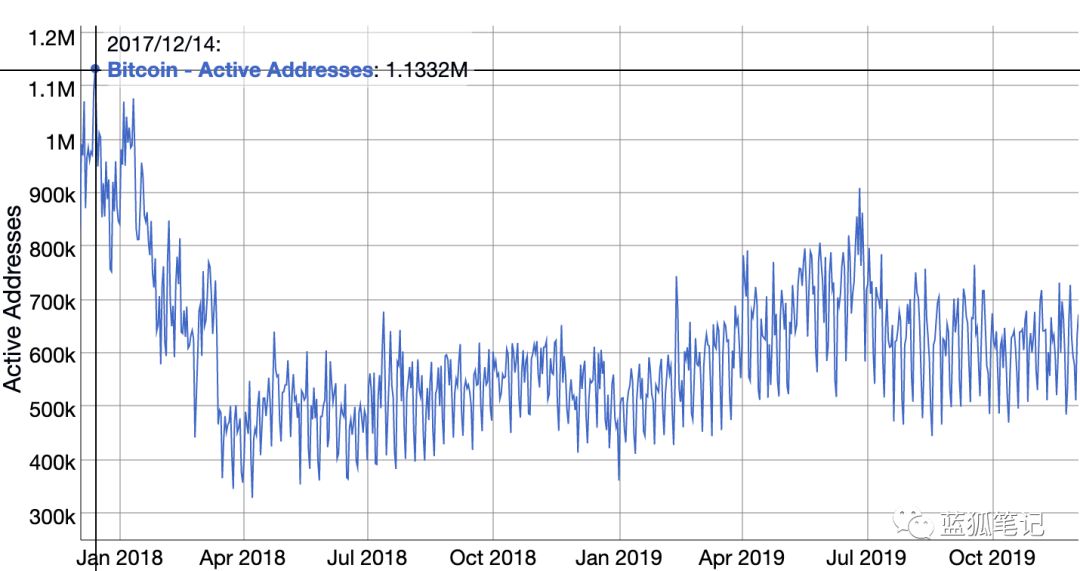Opinion: Bitcoin must cross the divide if it is to succeed
Editor's note: The original title was "Bitcoin Must Cross The Divide: If You Want To Succeed"
Foreword: If we look at the adoption phase of Bitcoin according to the technology adoption life cycle model, which stage is it currently in? The transition from the innovator phase to a small number of early adopters is just now. In the early adopter phase, there are two subgroups. Some of the early adopters are relatively open-minded and easy to accept new things, while the other group is relatively conservative. Whether they can be convinced to adopt them will be the key in the history of Bitcoin Milestones are similar to the arrival of singularities. Crossing the chasm is essentially breaking through this critical point. Once this obstacle is crossed and this chasm is crossed, the front is a vast grassland, a stepping grassland. There is still much to be done before reaching this point. Not only technological advances, but also the involvement of all early adopters. The writer is Sylvain Saurel, translated by "CQ" in the "Blue Fox Notes" community.
Since you are reading this article, you are at least interested in Bitcoin and the innovation it represents. In fact, the fact that you are interested in Bitcoin also makes me believe that you have more or less knowledge of the technology world. Therefore, the life cycle of technology adoption is discussed below.

No expert is needed in this area, I will go into detail below. On the other hand, you have to ask yourself the following question: As far as Bitcoin is concerned, at what stage of the technology adoption life cycle?
- 2019 China Blockchain Underlying Technology Platform Development Report: Nearly 50% of platforms have a total throughput of more than 10,000, and the trend of open source is becoming more apparent
- Babbitt Column | What are the improvements in the three major branches of Bitcoin in 2019?
- Blockchain-based diamond applet will go online? World's largest diamond mining company Alrosa and Tencent jointly develop
Therefore, I will do my best to answer this question and provide you with clues to understand what it means for the future of Bitcoin, and in particular the need to successfully cross the "gap stage" to achieve widespread adoption.
Technology adoption life cycle
The technology adoption life cycle is a sociological model that describes the degree of adoption or acceptance of innovative technology products related to a defined group of adopters.
For each adopter group, the life cycle of technology adoption must take into account specific demographic and psychological characteristics. Adopters are divided into 5 major groups, which were defined by agricultural researchers Beal and Bohlen in 1957:
- Innovators are more educated and more successful, so they are more willing to take greater risks
- Early adopters are younger and therefore less successful, but they are highly educated and often community leaders
- Most early adopters were relatively conservative people who remained open to new ideas and played an active role in the community, which could affect those around them
- Most late adopters tend to be less educated, and they are more conservative and less socially engaged than others in society
- Lagging adopters are the most conservative in society, and their education level is often limited
In recent decades, this model has been widely used in many fields. In Jeffrey Moore's book "Crossing the Divide," he proposes an adoption, which in the context of Bitcoin is particularly meaningful to us.

Jeffrey Moore argues that for non-continuous innovation, there is a gap between early adopters, splitting them into two subgroups. If this divide is successfully bridged through technology, mass adoption of disruptive technologies can be achieved. Examples from recent decades confirm the effectiveness of this adoption life cycle.
Bitcoin is in the divide stage
Bitcoin was created in early 2009, and its first few adopters were innovators. At that time, only enthusiastic technology enthusiasts were interested in Bitcoin, and its price was very low compared to today's price.
Bitcoin's first jump in price occurred at the end of 2013, and its price crossed the $ 1,000 mark for the first time. After reaching the first peak, the price of Bitcoin dropped back to around $ 250 and hovered for several years.
The transition from the innovator phase to the early adopter phase of bitcoin took place in 2017, when market frenzy led Bitcoin to a price of almost $ 20,000. From that moment, Bitcoin really entered the early adopter phase, and more and more young people discovered Bitcoin and began to see its full potential.
This can be seen from the sharp increase in Bitcoin's only active address in 2017, where active addresses crossed the 1 million mark:

Since entering this stage, we can feel that Bitcoin has been stagnant in terms of adopters, but it has been steadily advancing in terms of technological progress, and is improving every month.
This can be confirmed from the active addresses of the Bitcoin network, since the beginning of 2018, the number of active addresses has never exceeded one million:

Due to the possible opening of the Bitcoin bull market, the number of active addresses will increase considerably in 2019, but in December 2019, the number of active addresses per day will not exceed 800,000.
Therefore, we are still in the early adopter phase, but the adoption of Bitcoin technology faces a divide, which is what Jeffrey Moore calls the "divide."
Bitcoin must cross the divide
Faced with this divide, Bitcoin has no choice but to move on to achieve a successful leap. Without crossing the divide, it will not be able to achieve large-scale population adoption.
This stage is the most difficult stage for Bitcoin, and it is the part that all disruptive technologies have to go through.
Indeed, it is relatively easy to persuade early adopters, as this social group is relatively open-minded. Much work has to be done to bridge the gap between these early adopters and the more conservative early adopters.
However, it can be felt that Bitcoin is facing a special moment in its development history in the right way, and the public's awareness of Bitcoin is also increasing. Of course, for late adopters and laggard adopters, they have a strong willingness to keep Bitcoin out, and they are more concerned about the traditional currency system, which is in their favor.
Bitcoin's challenge now: Win the majority of early adopters in order to eventually reach the beginning of the majority of early adopters, and see the rapid development of Bitcoin adoption.
If Bitcoin crosses the divide, its future will be phenomenal
With the transition of Bitcoin from the innovator phase to the early adopter phase in 2017, its price growth is strong, which is all impressive. Indeed, it took only 12 months for the Bitcoin price to rise from only $ 1,000 to $ 20,000. The growth in the fourth quarter of 2017 was even more sudden, with the price of Bitcoin soaring directly from $ 3,000 to $ 20,000. (Blue Fox Note: This is related to the frenzy bubble environment of the first coin issuance at that time, not due to the sudden breakthrough of Bitcoin itself. This must be soberly understood. Of course, one of the potential benefits is to make everyone aware of Bitcoin. Future possibilities)
During the transition from the innovator phase to the early adopter phase, the number of unique Bitcoin addresses increased from 500,000 to just over 1.1 million. All of this is amazing, but it's only useful if Bitcoin successfully crosses the divide and eventually convinces a group of early adopters. By then, it will only be a matter of time before the majority of early adopters adopt, and a significant increase in price and number of users can be expected.
The biggest question left now is whether and when Bitcoin can bridge this divide. Whether the public can adopt Bitcoin on a large scale depends on the answer to this question.
Risk warning: All articles of Blue Fox Note can not be used as investment advice or recommendations. Investment is risky. Investment should consider personal risk tolerance. It is recommended to conduct in-depth inspection of the project and make good investment decisions.
We will continue to update Blocking; if you have any questions or suggestions, please contact us!
Was this article helpful?
93 out of 132 found this helpful
Related articles
- Interview with Babbitt 丨 5 years of exploration, 4 new products, 3 principles, the landing of Hang Seng Electronic Blockchain
- Forbes: U.S. cryptocurrency law expected to be launched in 2020, SEC, CFTC, FinCEN and three major institutions join forces
- Babbitt Column | Is it feasible to track the flow of digital assets?
- South Korea's largest telecommunications company KT develops blockchain local currency for Busan, officially launched on December 30
- Discussion: Impact of Digital Currency on Financial Accounting and Policy Suggestions
- The blockchain industry returns to rationality, and countries speed up the layout of the commanding heights of the technology
- China Banknote Researcher's View: Digital Currency from the Perspective of Physical Currency






